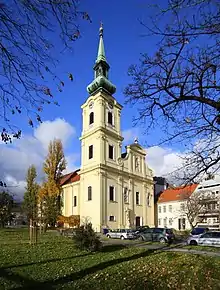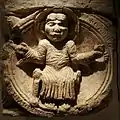St. Catherine of Alexandria Church, Budapest
The St. Catherine of Alexandria Church (Hungarian: Alexandriai Szent Katalin-templom, German: Pfarrkirche zur heiligen Katharina) is a Roman Catholic church in the Tabán quarter of Budapest, Hungary. It is the parish church of the Tabán Parish which also comprises parts of Gellért Hill and Naphegy. The church is a listed monument that was built in Central European Baroque style between 1728 and 1736.
| Saint Catherine of Alexandria Church | |
|---|---|
 The facade of the church | |

| |
| 47.49222°N 19.043955°E | |
| Location | 11 Attila út, Tabán, Várkerület district, Budapest |
| Country | Hungary |
| Denomination | Roman Catholic |
| Tradition | Latin |
| History | |
| Status | parish church (1702) |
| Founded | 1692 |
| Founder(s) | Cameral Administration of Buda |
| Dedication | Saint Catherine of Alexandria |
| Architecture | |
| Functional status | Active |
| Heritage designation | listed |
| Architect(s) | Christian Obergruber |
| Architectural type | Single-nave church |
| Style | Central European Baroque |
| Completed | 1749 |
| Specifications | |
| Number of spires | 1 |
| Materials | stone and brick |
| Administration | |
| Diocese | Roman Catholic Archdiocese of Esztergom–Budapest |
History
Early history
The southern part of the lower town between Castle Hill and Gellért Hill was devastated by the Siege of Buda in 1686, and had few inhabitants until November 1690 when a group of South Slavic refugees were settled there by the Cameral Administration. The majority of the new arrivals were Orthodox Serbs who built their own quarter on the banks of the Ördög-árok stream. Their chapel later became the Cathedral of the Holy Trinity. The Roman Catholics settled on the southern slopes of Castle Hill and near the Danube around the Mosque of Sokollu Mustafa Pasha which survived the war.[1]
In 1689 the head of the Cameral Administration of Buda, Johann Stephan Werlein asked the Franciscans of Bosna Argentina, who had a house in the Víziváros district, to take on the pastoral care of the Catholic Slavs who lived in this area. The Franciscan fathers already had a presence in Buda during the Ottoman period, and they spoke the Illyric language. The Mosque of Sokollu Mustafa Pasha was converted into a chapel in 1692 and it was consecrated to St. Catherine of Alexandria. A house was built by the chapel for the friar who settled there in 1693.[2] The friar also served as a schoolmaster because the Franciscans built a school on the edge of the cemetery which had been established around the chapel. The small stone building had a single room, and a few shops provided income for its maintenance. The Cameral Administration has granted approval to finish the construction of these shops on 31 May 1697.[3]
The parish was established in 1702, and its patron was the Council of Buda according to the 1703 letter of privilege of the town. The guardian of the Víziváros friary served as parish priest but the actual pastoral care was entrusted to a Franciscan administrator who lived in Tabán. The baptismal register was started in 1692, the marriage and burial records have been kept from 1709. In 1706 the council granted a 2.3 ha vineyard on Gellért Hill to the parish.
The Baroque church
Tabán quickly became the most densely populated quarter of Buda in the first decades of the 18th century in spite of the several natural disasters and epidemics that hit the district. The number and percentage of the Catholic population also increased. In 1702 there were only 250 Catholics among the taxpayer heads of families (the Orthodox Serbs numbered 461) but the 1756 canonical visitation found more than 4000 the Catholics in Tabán. Their number grew to almost 5000 in 1802. At first almost all of them were Illyrs (South Slavs) but German immigrants arrived in large numbers from the 1720s. In 1783 the Germans already outnumbered the Illyrs while the Hungarians and the Slovaks were still few in numbers. From the middle of the 18th century sermons were delivered in German and Illyric, and teaching in the parish school was also bilingual.[4]
The church was enlarged between 1728 and 1736, the work was led by master Christian Obergruber.[5] The furnishings of the church are from 1748, including the pulpit and the atarpiece.[5] The crypt was built in 1749.[5] In the foreground is the "Tabán Christ", a Romanesque[5] tympanum fragment dating back to the 12th century, which was secondary to the wall of St. Catherine's Church.
Gallery
 The church in 1830
The church in 1830_Fortepan_10633.jpg.webp) Tabán in 1942, to the left the St Demeter Church of the Racis
Tabán in 1942, to the left the St Demeter Church of the Racis View of the church from the Gellért Hill
View of the church from the Gellért Hill Interior
Interior the 12th-century tympanum "Tabán Christ"
the 12th-century tympanum "Tabán Christ" Holy Sepulcher
Holy Sepulcher Altarpiece
Altarpiece
References
- Nagy Lajos: Budapest története III. A török kiűzetéstől a márciusi forradalomig, Akadémiai Kiadó, Budapest, 1975, p. 144
- Rédey Rezső: Tabán és a 900 éves tabáni plébánia, Budapest, 1939, pp. 19-20
- Nándor Kaizer: A ferencrendiek Budapest-Tabánban, Magyar Ferences Könyvtár
- Fejérdy András: A tabáni Alexandriai Szent Katalin plébánia, In: Katolikus Budapest I–II. Általános történeti szempontok. Plébániák. ed. Beke Margit. Budapest, 2013. pp. 386-387
- "Budapest-Tabán Alexandriai Szent Katalin-plébánia (Parish of St. Catherine of Alexandria in Tabán-Budapest)". ittlakunk.hu.
See also
| Wikimedia Commons has media related to Saint Catherine Church (Tabán). |
